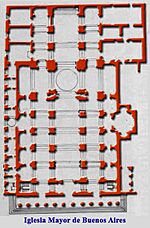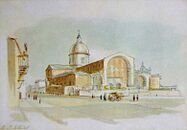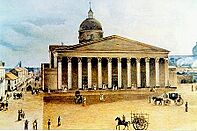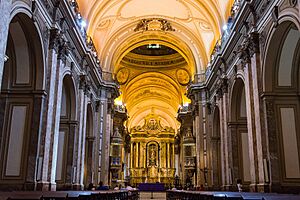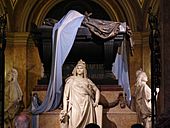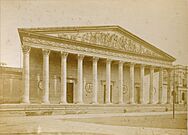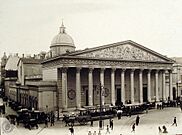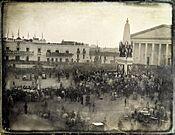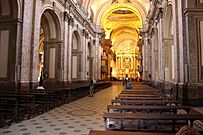Buenos Aires Metropolitan Cathedral facts for kids
Quick facts for kids Buenos AiresMetropolitan Cathedral |
|
|---|---|
|
Catedral Metropolitana de la Santísima Trinidad de Buenos Aires
|
|
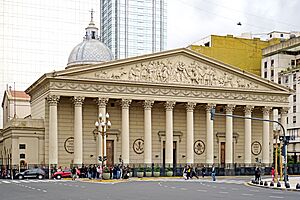
The front of the cathedral looks like an ancient Greek temple.
|
|
| Religion | |
| Affiliation | Roman Catholic |
| District | Archdiocese of Buenos Aires (since 1822) |
| Ecclesiastical or organizational status | Cathedral |
| Year consecrated | 1779 (as Cathedral) |
| Location | |
| Municipality | Buenos Aires |
| Architecture | |
| Architect(s) |
|
| Architectural style | Spanish Colonial Neoclassical |
| Date established | 1593 (first chapel) |
| Groundbreaking | 1754 |
| Completed | 1822 |
| Direction of façade | San Martín 27 |
The Metropolitan Cathedral of the Most Holy Trinity (in Spanish: Catedral Metropolitana de la Santísima Trinidad) is a famous Roman Catholic Cathedral in Buenos Aires, the capital city of Argentina.
It is located in the heart of the city, right next to the famous Plaza de Mayo. The cathedral is the main church for the Archdiocese of Buenos Aires. For its importance and long history, it was named a National Historic Monument in 1942.
Contents
A History of Rebuilding
The cathedral that stands today is the result of many years of construction and several rebuilds. The spot for the church was chosen way back in 1580 when the city of Buenos Aires was founded by Juan de Garay.
The First Churches
The very first church was a simple building made of adobe (mud bricks) and wood. By 1605, it was already old and falling apart, so it was torn down. A new one was built, but it was also poorly made. Its roof was about to fall in by 1616, and eventually, the whole building collapsed.
A third church was quickly built in 1618, but it was smaller than the one before. Around this time, in 1620, the church was officially named a "cathedral." However, the new bishop was not impressed. He wrote to the king of Spain that the building was in such bad shape that even barns in Spain were nicer.
The Second Cathedral
In 1662, a new plan was made to build a much grander cathedral with three sections called naves. This new church was finished in 1671. It had a wooden roof and a tall tower.
Unfortunately, this "new" cathedral was built with cheap materials. Just seven years later, it started to fall apart. By the 1680s, the roof and tower had collapsed. The church had to be rebuilt yet again, a project that started in 1684. By 1695, it was mostly done, but the towers and a special room called the sacristy were still not finished.
The Cathedral We See Today
On the night of May 23, 1752, disaster struck again! The main part of the cathedral collapsed. Only the front wall (the façade) and the towers were left standing. Everything else had to be rebuilt from scratch.
An Italian architect named Antonio Masella was hired to design a much bigger and more impressive church. He planned for a large dome over the center. However, after the dome was built, cracks appeared, and it had to be rebuilt.
The old façade and towers were finally torn down in 1778 because they looked too small for the new, larger building. For a long time, the cathedral had no front entrance.
Finally, in the 1820s, French architects Prosper Catelin and Pierre Benoit designed the grand front we see today. They were inspired by the Palais Bourbon in Paris. It has twelve massive columns and a triangular top part called a pediment, making it look more like an ancient Greek or Roman temple than a typical church.
The decorations on the front were not finished until the 1860s. A French sculptor, Joseph Dubourdieu, carved the scene on the pediment. It shows the Bible story of Joseph meeting his brothers and father in Egypt. This was meant to be a symbol of Argentina becoming a united country.
Inside the Cathedral
The inside of the cathedral is shaped like a Latin cross. The walls and ceilings are covered with beautiful paintings of Bible stories, created by the Italian artist Francesco Paolo Parisi. The floor is decorated with colorful mosaics in a Venetian style, which were restored in 2010.
Some parts of the interior are very old. The main altarpiece, which is the decorated structure behind the altar, is made of carved wood covered in gold. It was made in 1785 in the Rococo style. It features a statue of the Virgin Mary and a symbol of the Holy Trinity.
Another important statue is the Christ of Buenos Aires, a large figure of Jesus on the cross. It was carved in 1671, making it the oldest statue in the cathedral.
The cathedral also has a huge pipe organ built in Germany in 1871. It has over 3,500 pipes and is considered one of the best organs of its kind in the world.
Mausoleum of General San Martín
In 1880, the body of General José de San Martín, a national hero who helped free Argentina, Chile, and Peru from Spanish rule, was brought back from France. His remains are now in a special tomb, or mausoleum, inside the cathedral.
The mausoleum was designed by the French sculptor Albert-Ernest Carrier-Belleuse. The black tomb is guarded by three large female statues made of marble. Each statue represents one of the countries San Martín helped to liberate: Argentina, Chile, and Peru.
Pope Francis and the Cathedral
Pope Francis was the Archbishop of Buenos Aires for 15 years before he became the Pope in 2013. When he was Archbishop Jorge Bergoglio, this cathedral was his home church, and he often led services here.
Today, the cathedral has a museum dedicated to him, called the Pope Francis Museum. It displays some of his personal items and the special clothing he wore during church services.
Gallery
See also
 In Spanish: Catedral metropolitana de Buenos Aires para niños
In Spanish: Catedral metropolitana de Buenos Aires para niños
- Plaza de Mayo
- Religion in Argentina
- Roman Catholicism in Argentina
- Architecture of Argentina
- Archdiocese of Buenos Aires


